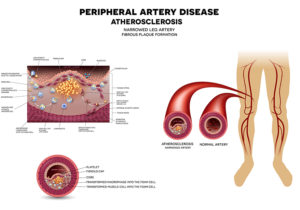Peripheral Arterial Disease (PAD) refers to diseases of the vascular system. PAD is a condition when plaque build-up causes a narrowing or blockage of the arteries. Left untreated, the plaque can harden in a process called atherosclerosis which reduces blood flow to the limbs.

PAD typically affects the legs, ankles, and feet. Patients may experience uncomfortable symptoms such as leg pain while walking, pain at rest, reduced pulse, and skin temperature changes, due to reduced blood flow.
Over time, PAD can significantly affect a patient’s mobility and quality of life. Those with PAD are more susceptible to stroke and heart attack. The advanced stage of PAD is called Critical Limb Ischemia (CLI). CLI can result in severe health complications, non-healing wounds, and muscle wasting.
PAD Risk Assessment Forms [ENGLISH][SPANISH]
Risk Factors & Symptoms of PAD
Peripheral Arterial Disease affects approximately 8.5 million people in the United States. Approximately 17% of people with PAD are over 60 years of age. Risk factors associated with PAD are smoking, diabetes, high blood pressure, kidney failure, obesity, and history of stroke or heart disease.
Some patients with PAD experience mild to no symptoms, while others may experience severe symptoms, including:
- Claudication – pain or heaviness in the legs while walking or exercising
- Pain at Rest
- Pulse Change – a reduction or absence of a pulse in the ankle or foot
- Temperature Changes – skin may feel cooler in one limb compared to the other
- Non-Healing Wounds – sores, ulcers, or wounds on legs, feet, or toes that heal slowly or not at all
Diagnosis of PAD
If you believe you may have Peripheral Arterial Disease, it is crucial to receive a proper diagnosis. At Pennsylvania Vascular Institute, we may perform one or more of the following diagnostic tests:
- Ankle-Brachial Index (ABI) --measures blood pressures and blood flow
- Duplex Ultrasound -- examines blood flow in the legs
- Computed Tomography Angiography (CTA) --utilizes CT Scanner to visualize blood vessels
- Magnetic Resonance Angiography (MRA) -- utilizes MRI to measure the severity of disease
Treatment for PAD
The clinicians at Pennsylvania Vascular Institute are specialized in the diagnosis and treatment of Peripheral Arterial Disease. Treatment options include:
- Angioplasty -- a thin catheter is placed into the blood vessel and a balloon is inflated to open the blockage
- Stent Placement -- a mesh tube is permanently inserted into the diseased vessel to hold the blockage open
- Atherectomy -- mechanical device utilized to remove hardened plaque from diseased vessels
At Pennsylvania Vascular Institute, you can expect your procedure to last approximately 1 hour, with an average recovery time of only 2 hours. Our compassionate staff will ensure your comfort throughout your same day procedure.
